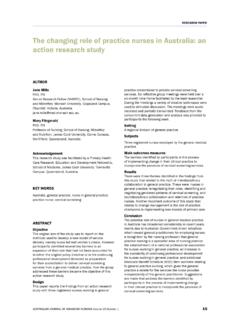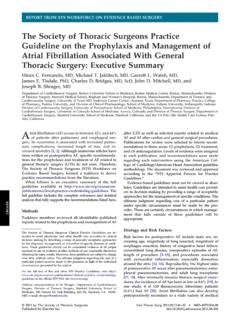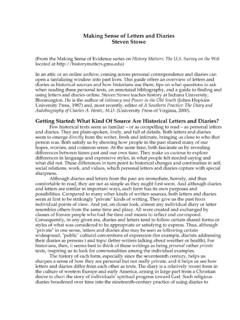Transcription of Inclusive Education Research & Practice - MCIE
1 MARYLAND COALITION FOR Inclusive Education , 2010 1 Inclusive Education Research & Practice Xuan Bui, Carol Quirk, Selene Almazan, Michele Valenti Inclusion Works! Over 20 years of Research has consistently demonstrated that the inclusion of students with disabilities in general Education classrooms results in favorable outcomes. Positive outcomes have been shown for both students with high incidence disabilities (learning disabilities and other mild disabilities) and those with low incidence disabilities (intellectual, multiple, and severe disabilities). This body of Research includes quantitative studies where the standard is replication as well as qualitative studies that aim for complete, detailed descriptions in order to answer how questions.
2 Placement Matters: Studies investigating the effects of placement in general Education classrooms reveal positive outcomes in the areas of IEP quality, time of engagement, and individualized supports. Significant increases in IEP quality on measures of age-appropriateness, functionality, and generalization were found when students moved into general Education classes from special Education settings even though the special educator remained the same (Hunt & Farron-Davis, 1992). Within the general Education classroom, there was an increase in the amount of instruction on functional activities as well as basic academic skills such as literacy for students with severe disabilities (Hunt, Farron-Davis, Beckstead, Curtis, & Goetz, 1994).
3 In addition, students were observed to be less engaged and often more alone in self-contained classrooms. Similar student engagement outcomes were reported in a study involving nine elementary students with severe disabilities who were observed in both special and general Education settings. General Education classrooms delivered more instruction, provided a comparable amount of 1:1 instruction time, addressed content more, and used non-disabled peers more and adults less (Helmstetter, Curry, Brennan, & Sampson-Saul, 1998). Furthermore, comparisons of the two settings revealed a significant difference in non-instructional time.
4 In self-contained classes, 58% of the time was classified as non-instructional versus 35% of the time in general Education classes. To answer the question of individualizing supports, McDonnell and colleagues compared the instructional contexts of students with low incidence disabilities and their typical peers in Placement in general Education results in: Improved IEP quality More student engagement Increase in instructional time Maintenance of individualized supports MARYLAND COALITION FOR Inclusive Education , 2010 2 general Education settings. The students with severe disabilities were 13 times more likely than their peers without disabilities to receive instruction directed exclusively toward them during whole class activities, and were 23 times more likely to receive 1:1 instruction (McDonnell, Thorson, & McQuivey, 2000).
5 This challenges the prevalent notion that students with disabilities cannot receive individualized supports in general Education classrooms. Outcomes for Students with Disabilities: Most Research studies examining educational outcomes have found positive effects for inclusion. Baker and colleagues reviewed three meta-analyses that addressed the issue of the most effective setting for the Education of students with disabilities. A small-to-moderate positive effect for Inclusive placement was found in all three meta-analyses (Baker, Wang, & Walberg, 1994). More recently, Waldron, Cole, and Majd (2001) investigated the effects of Inclusive programs for students with high incidence disabilities and their typical peers.
6 This two-year study found that of students with learning disabilities made progress in math in general Education classes compared to 34% in traditional special Education settings, without the presence of nondisabled peers. Gains in reading were comparable in both settings. When comparing progress with their typical peers, of students with disabilities made comparable or greater progress in math in Inclusive settings versus in traditional settings. Similar academic gains were reported in a study examining the use of class-wide peer tutoring on the achievement of students with high incidence disabilities in Inclusive classrooms.
7 Significant increases in spelling, social studies and other academic indicators were observed (Pomerantz, Windell, & Smith, 1994). Positive educational outcomes are not in the area of academics alone. The National Longitudinal Transition Study examined the outcomes of 11,000 students with a range of disabilities and found that more time spent in a general Education classroom was positively correlated with: a) fewer absences from school, b) fewer referrals for disruptive behavior, and c) better outcomes after high school in the areas of employment and independent living (Wagner, Newman, Cameto, & Levine, 2006).
8 Meta-analyses and comparative studies examining the educational outcomes of students with low incidence disabilities in Inclusive versus segregated classrooms have found either no difference in outcomes or positive effects for inclusion (Hunt & Goetz, 1997). There is a body of empirical evidence that shows students with severe disabilities are able to acquire skills in a range of areas within Inclusive classrooms. McGregor and Vogelsberg (1998) report that students demonstrate higher levels of social interaction with typical peers, social competence and communication skills improve ( , Hunt, Alwell, Farron-Davis & Goetz, 1996), and academic gains are made (McDonnell, Thorson, McQuivey, & Kiefer-O Donnell, 1997).
9 In For students with high incidence disabilities, a higher percentage of make academic progress in general Education classes compared to students in traditional, resource settings. MARYLAND COALITION FOR Inclusive Education , 2010 3 addition, Kliewer and Biklen (2001) found that Inclusive learning environments facilitated the acquisition of literacy and adaptive skills as well as enhancing students social relationships. In this domain of social outcomes, Fisher and Meyer (2002) conducted a two-year longitudinal study to examine social competence for 40 students with severe disabilities in Inclusive and self-contained classrooms.
10 Students in the Inclusive settings had significantly higher mean scores on the ASC (Assessment of Social Competence) after a two-year period, and although students in self-contained classrooms made gains, they were not statistically significant. Falvey (2004) notes that no studies conducted since the late 1970 s have shown an academic advantage for students with intellectual and other developmental disabilities educated in separate settings. Effect on typical peers: Concerns are often raised about the impact that students with disabilities, especially those with challenging behavior, have on the learning of typical students.






